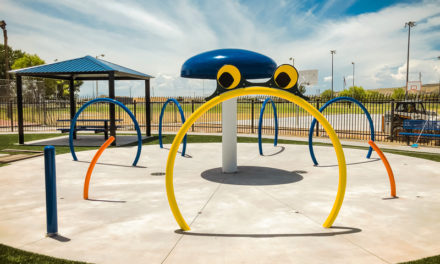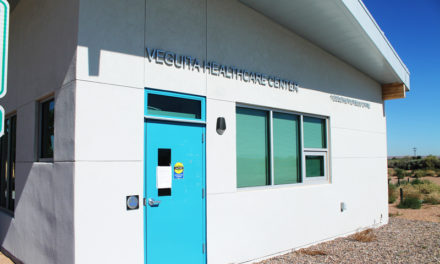(La Historia del Rio Abajo is a monthly column about Valencia County history written by members of the Valencia County Historical Society. Readers are encouraged to share memories about the subjects of current columns by calling Richard Melzer, La Historia’s editor, at 925-8620.)
A single-engine Piper Cherokee (N5752W) took off from Mid-Valley Airport at 6:55 a.m. on Thursday, Oct. 23, 1969. A pilot and two passengers were on board the small white plane that fateful day nearly 33 years ago.
All three men thought of their planned three-and-a-half-hour trip to Denver as an adventure. They had no idea how much of an adventure lay ahead as they peered into the morning sky.
The rented Cherokee Piper was piloted by 18-year-old Albert Stacy Torres. The second oldest in a family of seven children, Stacy had started flying in June, 1968, and had received his private pilot’s license on June 15, 1969.
According to his flight instructor, Jerry Arnold, Stacy “caught on quickly, was very sharp and was a really confident” young pilot. By October, 1969, he had logged 100 hours of flight time.
Stacey had just recently graduated in the class of 1969 at Belen High School. His senior yearbook noted that he had won awards in math and science, had belonged to the school’s rocket club and had served as the president of the local chapter of Vocational Industrial Clubs of America (VICA) for two years.
Reflecting his interest in math and science, Stacy was a freshman majoring in engineering at the University of New Mexico in the fall of 1969. His dream was to combine what he loved most: to own a ranch in Canada with an airstrip so that he could fly to distant places to work as an engineer.
Stacy was accompanied by his 43-year-old father, Alfonso “Al” Torres, as the Piper plane lifted off the runway on that October morning in 1969. Al was a native of Tomé, the youngest of five brothers. After serving in World War II, he was honorably discharged from the Navy in 1945. Al had returned to New Mexico to open a car repair business in Tomé.
Three years later, Al married Charolette Ulibarri of Jarales and soon moved his business to River Road outside of Belen. An active community leader, he belonged to the Knights of Columbus as Our Lady of Belen Catholic Church and served as a volunteer fireman for many years.
Charlotte Torres remembers that Al loved outdoor adventure. He liked hunting, boating, skiing, swimming and flying. Al flew every chance he got when he was young.
Respected as an excellent mechanic, Al enjoyed working with machines and building his own vehicles. He built a small tractor for yard work as well as a recreational vehicle for trips as far away as California.
Al and Stacy had recently designed a mercury switch that could warn truck drivers when their heavy equipment vehicles were in danger of overheating. In fact, Al and Stacy were en route to Denver to meet with a lawyer who was doing research to see whether or not a patent for their invention already existed. Typically, Al was less interested in the patent and potential profits for himself and more interested in giving Stacy the experience of seeing how patents worked for his future career in engineering.
The second passenger on the Piper Cherokee was Al Torres’s friend, 38-year-old Orlindo “Lindy” Garcia. Lindy was a Belen native and a Korean War veteran with a degree in business from the University of New Mexico. A bachelor, he ran his own bookkeeping business in Belen. Al was one of Lindy’s many clients. Like Al, Lindy was active in the Belen community, especially in the local Lions Club and at Our Lady of Belen Catholic Church.
Lindy was “along for the ride” on Oct. 23. He had looked forward to the trip and apparently had little fear for his safety. When Charlotte Torres asked him if he had any trepidation about the flight, he reminded her that he was taking survival classes and felt confident that all would go well with Stacy in the pilot’s seat and Al close by. Lindy had survived a vacation in the jungles of Mazatlan, Mexico. Why shouldn’t he survive a plane trip to Denver?
Stacy, Al and Lindy’s flight went well as they flew north into Albuquerque. There, at Coronado Airport, they landed to pick up another passenger, Tom Mayhew. Stacy had met Tom at UNM where Tom was a fine arts major in his third year at the university.
Born in Pueblo, Colo., Tom had grown up in Farmington, N.M., where his dad worked as a geologist for Shell Oil Company. Friends recall that Tom was eager to go to Denver to see his girlfriend and make amends after a recent fight.
Tom had a fellow student from his UNM dorm take him to the airport to meet Stacy’s plane. Clearly anxious to get going, Tom had gotten up at 4:30 and had arrived at the airport by 5:30 a.m. At least one airport worker saw the Piper Cherokee land and Tom climb on board.
But there were difficult conditions to contend with as the Piper headed further north. The weather was growing worse. Falling snow and dense fog made flying extremely hazardous. Stacy and his passengers could not have known how bad things were ahead.
With no word from Stacy or his passengers by late morning, when they were due to arrive in Denver, people began to fear for their safety. Charlotte, who worked in the office at her husband’s business, recalls having a “weird feeling” at work that morning. Lindy’s sister, Dylia Castillo, recalls having a similar “really uneasy” feeling at about the same time at her job with the Belen schools. Worried, Charlotte called the airport to check on her husband’s and son’s safety.
By 1 p.m., airport officials called Charlotte to report that they were concerned that the Piper Cherokee might be lost or, worse, might have crashed somewhere in the wilderness of northern New Mexico. The men had not arrived for their late morning appointment in Denver, and their five-hour supply of fuel would have been used up by about noon. It was time to alert the authorities and launch a search. If the plane had crashed, time was of the essence in rescuing the possibly injured men on board.
As word spread of the apparent disaster, dozens of friends, relatives and complete strangers volunteered to help in any way they could. In the next few days, search and rescue teams covered large areas on the ground while 17 search planes scoured the surface from the sky. Fires and any suspicious-looking white objects seen from a distance were checked out on land or from the air.
Teams of three to five men traveled in four-wheel-drive vehicles, on horseback and by foot over rough terrain.
One five-man crew from Belen entered the Pecos Wildnerness. Led by seasoned outdoorsman David Chavez, the search team headed for Santa Barbara Canyon. The men feared that Stacy’s small plane might have had difficulty climbing out over the canyon’s steep walls in an emergency.
At first, the local Forest Ranger would not permit Chavez and his fellow searchers to enter Santa Barbara Canyon in such poor weather conditions. The ranger only allowed the men to proceed when they convinced him that Chavez knew the terrain like the back of his hand, having gone on countless hunting trips in the Pecos Wilderness.
David Chavez recalls that the going was rough from the start. One man turned back almost immediately. Two others could go no further after a rough night sleeping in freezing temperatures in snow up to 18 inches deep.
Of the original five, only Chavez and his friend, Arsenio Baldonado, remained to search through the canyon and climb far up Truchas Peak. It was a true test of endurance. But no trace of the lost plane or its pilot and passengers could be found.
Not discouraged, Baldonado returned to northern New Mexico to continue the search over many weeks. A contractor who had built Al Torres’s garage on River Road, Baldonado even brought his young son, Arsenio Jr., to help search. Baldonado recalls several exciting moments, including once when he came across two wild dogs and another time when he faced a wild bear.
Baladonado joined Al Torres’s oldest son, Nolbert, and Nolbert’s uncles, Richard Ulibarri, Terry Ulibarri and Serafico Carrillo, in a search effort along the ridge of the Rio Grande Gorge. Searching in vain, the five-man team almost froze to death before finally being picked up by truck. Other groups had similarly harrowing experiences. But Nolbert and the others kept going back, time after time.
Exhausted searchers ate when they could and slept on floors, in trucks and wherever they could find room, giving little thought to their own comfort or convenience. Rural residents of northern New Mexico were consistently generous and sympathetic.
When not hiking or climbing, volunteers questioned local people along the Piper Cherokee’s planned flight path. Some reports were encouraging. A veteran pilot said he had heard a plane flying at a low altitude with what sounded like a “troubled” engine near Peñasco about 10 a.m. on Oct. 23. Thirteen-year-old Mary Ann Brown had seen a similar plane near Llano at about the same time.
A deer hunter in the area saw a small, frightened bassett hound and wondered if it could have belonged to someone on the plane and had somehow survived a crash. Four days after the plane’s disappearance, a Pan American pilot flying over the area reported seeing plane wreckage just north of the Colorado border.
Family members and friends remained generally optimistic through the first weeks of the search for the four men and their plane. Alvarado Torres, Al’s brother, confirmed that the four travelers had warm clothing and were well prepared for cold weather conditions. Charlotte Torres had faith in her husband’s and son’s ability to improvise and deal with crises. Charlotte recalled Lindy’s confidence in his survival skills. News circulated that Tom Mayhew was a well-trained Eagle Scout.
Many groups and hundreds of individuals helped in valuable ways. Countless prayers were offered at Our Lady of Belen and other community churches. State Sen. Tibo J. Chavez secured the use of a search helicopter and called Gov. Dave Cargo to enlist additional help. Los Lunas School Superintendent Bernard Baca also secured the use of a plane in which he flew to aid in the search.
The New Mexico and Colorado Civil Air Patrols, the U.S. Forest Service, the U.S. Game and Fish Department, the New Mexico State Police and the U.S. Marshal’s office were similarly generous with their time and resources.
Reward money was offered as well. The First National Bank of Belen, led by John C. Johnson, offered a $1,000 reward for information that might lead to finding the lost aircraft and the passengers on board. An account to help fund the search effort was also opened at the bank.
The Farm Bureau added a hundred dollars to the offered reward. Dylia Castillo and her husband, Ralph, placed hundreds of handbills announcing the reward money in post offices throughout northern New Mexico and southern Colorado.
Despite these many efforts, nothing of the Piper Cherokee, its young pilot, or its three passengers was discovered in late October or early November, 1969. The search continued, but the odds of a successful rescue declined as the weeks passed and winter weather made traveling impossible much of the time.
To make matters worse, none of the earlier leads had borne fruit. After some investigation, searchers discovered that Tom Mayhew had recently purchased a dog, but it was a spaniel rather than a basset hound. The crash site reported by the Pan American pilot was never found. And white objects seen in the distance consistently turned out to be other things.
Frustrated, the Civil Air Patrol suspended its search in the first week of November. With most of the northern mountains blanketed in snow, any crash site would be covered in white until the following spring or summer.
It was a trying period for everyone who waited for news. Therese, Al Torres’s oldest daughter, remembers that she and other members of her family “held our breath every time the phone rang.” As Dylia Castillo recalls, the victims’ families were left in limbo in what seemed like an endless nightmare.
Prayers for the lost men continued through the winter, but the chances of their survival grew dimmer and dimmer with time.
Part 2 of this story will appear in the June 22 edition.
(Dr. Richard Melzer is a professor of history at the University of New Mexico-Valencia Campus and has been active for many years in the Valencia County Historical Society. He is currently writing a pictorial history of the county with fellow historian Dr. Maggie McDonald.)
The Valencia County News-Bulletin is a locally owned and operated community newspaper, dedicated to serving Valencia County since 1910 through the highest journalistic and professional business standards. The VCNB is published weekly on Thursdays, including holidays both in print and online.

















